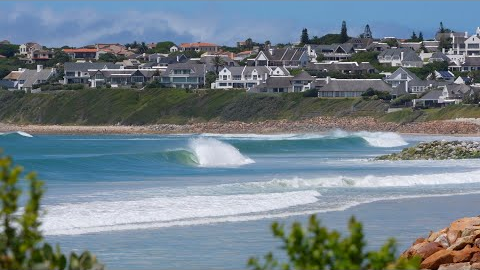Man Made Ocean "Wave Pool" St Francis Bay Groynes!
1,755 View
Share this Video
- Publish Date:
- November 23, 2025
- Category:
- Surfing
- Video License
- Standard License
- Imported From:
- Youtube

Pure joy.
That’s the hit I got while filming this newly formed righthand runner—an unexpected gem that lit me up in a way I haven’t felt in years. Why now, at 55? I think it’s that spark of discovery… that rare moment when perfection reveals itself and reminds you why you fell in love with surfing in the first place.
When Bruce Brown first stumbled onto Bruce’s Beauties, it was the pinnacle—proof that the hunt for something new, something flawless, is worth every dusty mile. And even today, in a modern surf world fuelled by wave pools and machine-made perfection, we’re still chasing that same feeling. How many times have you clicked on a thumbnail hoping to be mesmerized by the next artificial, spool-up, square-off miracle? They’re popping up everywhere, but the magic of real waves—born from tides, sand, wind, and luck—hits different.
And that’s why this moment feels so special.
Because right here in St Francis Bay, off a half-finished groyne, a fresh little righthander has woken up. What I captured in this video won’t look the same next year. As the groyne extends and the sand-pumping reshapes the banks, this wave will morph—maybe better, maybe gone, maybe reborn. All we can do is watch, hope, and dream.
I can’t help but feel the spirit of Bruce Brown hovering over this coastline. These new waves feel like a collaboration between the sea and us humans—part of a bigger, almost divine plan to gift surfers something new in St Francis Bay. A reminder that the search never ends, even in your backyard.
Thanks for watching, as always.
Brad
st francis bay surfing, st francis bay groyne update, bruces beauties, new right hander st francis, dtl surf, surf st francis 2025, south africa surfing, right hand point break, new wave discovery, surf exploration, surfing south africa 4k, surf vlog st francis bay, surfing documentary style, sandbank formation surf, groyne construction surf, perfect right hander, surf edit st francis, surfing st francis bay new wave, surf cinematography, natural wave perfection, surfing over 50, surfing lifestyle, surf travel south africa, surf channel 2025, trending surf 2025, wave formation time lapse, surf filmmaker south africa
-----------------------------------
Exploring Water Temperature Trends: Seasonal Variations, Ocean Warming, and the Future of Marine Ecosystems
Water temperature trends are a critical indicator of our planet's health. As we navigate the complexities of climate change, understanding how water temperatures fluctuate and affect marine life becomes increasingly important. This article delves into the seasonal variations, ocean warming, and the future of marine ecosystems, providing actionable insights and valuable information on this pressing issue.
Climate Change: The Driving Force Behind Changing Water Temperatures
Climate change is at the forefront of altering water temperature trends globally. Rising global temperatures lead to warmer oceans, which in turn affect weather patterns, sea levels, and marine biodiversity. The connection between atmospheric temperatures and oceanic changes is undeniable, and addressing climate change is essential for mitigating its impact on water temperatures.
Ocean Warming: Impacts on Marine Life and Ecosystems
Ocean warming poses significant threats to marine ecosystems. Increased temperatures can lead to coral bleaching, disrupt fish migration patterns, and reduce oxygen levels in the water. These changes not only harm marine species but also affect human communities that rely on the ocean for food, recreation, and economic activities. Understanding ocean warming is crucial for developing strategies to protect and preserve marine life.
Seasonal Variations: Understanding the Natural Fluctuations
Seasonal variations play a significant role in water temperature trends. Different seasons bring about changes in sunlight, precipitation, and wind patterns, all of which influence water temperatures. For example, summer months typically see higher sea surface temperatures, while winter brings cooler waters. Recognizing these natural fluctuations helps differentiate between regular seasonal changes and long-term trends caused by climate change.
Thermal Pollution: Human Activities Altering Water Temperatures
Thermal pollution, often resulting from industrial processes and urban runoff, introduces excess heat into water bodies. This artificial heating can disrupt local ecosystems, harming aquatic life and altering natural temperature patterns. By minimizing thermal pollution through better regulation and sustainable practices, we can help maintain healthier water temperatures and protect marine environments.
The Hydrological Cycle: Its Role in Modulating Water Temperatures
The hydrological cycle is a fundamental process that influences water temperatures. Evaporation, condensation, and precipitation work together to distribute heat energy across the globe. Changes in the hydrological cycle, driven by climate change, can alter water temperatures in both freshwater and marine systems. Understanding this cycle is essential for predicting and managing future temperature trends.
Marine Ecosystems: Adapting to Changing Water Temperatures
Marine ecosystems are highly sensitive to changes in water temperatures. As temperatures rise, species must adapt, migrate, or face the risk of extinction. Coral reefs, often referred to as the "rainforests of the sea," are particularly vulnerable to warming waters. Protecting these ecosystems requires comprehensive strategies that address both the causes and effects of changing water temperatures.
Future Outlook: Navigating the Challenges Ahead
Looking ahead, the future of marine ecosystems hinges on our ability to address water temperature trends effectively. Implementing sustainable practices, reducing greenhouse gas emissions, and investing in research are critical steps toward mitigating the adverse effects of climate change on water temperatures. By staying informed and proactive, we can work towards a more resilient and thriving marine environment.
In conclusion, water temperature trends offer valuable insights into the health of our planet. By understanding the interplay between climate change, ocean warming, seasonal variations, thermal pollution, the hydrological cycle, and marine ecosystems, we can develop informed strategies to protect and sustain our marine environments for future generations.











